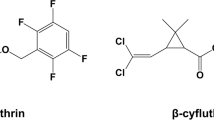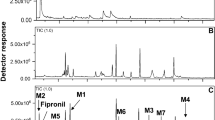Summary
Six strains of fungi grown on Sabouraud dextrose broth in the presence of 7,12-dimethylbenz[a]anthracene (DMBA) were surveyed for their ability to metabolize DMBA. Experiments with [14C]DMBA indicated that the extent of formation of organic-soluble metabolites ranged from 6 to 28% after 5 days of incubation, depending on the organism tested. The yields of water-soluble metabolites also varied, and ranged from 1 to 33% after 5 days.Cunninghamella elegans ATCC 36112 andSyncephalastrum racemosum UT-70 exhibited the highest DMBA-metabolizing activity among the organisms surveyed.S. racemosum metabolized DMBA primarily to 7-hydroxymethyl-12-methylbenz[a]anthracene (7-OHM-12-MBA)_ and 7,12-dihydroxymethylbenz[a]anthracene (7,12-diOHMBA). Minor metabolites included 7-OHM-12-MBA-trans-5,6-, 8,9- and 10,11-dihydrodiols, and glucuronide and sulfate conjugates of phenolic derivatives of DMBA. In contrast, the major DMBA metabolites produced byC. elegans were water-soluble. The predominant organic-soluble metabolites produced byC. elegans included 7-OHM-12-MBA-trans-5,6-, 8,9- and 10,11-dihydrodiols. DMBA-trans-3,4-dihydrodiol was also detected. Circular dichroism spectral analysis revealed that the major enantiomer of the 7-OHM-12-MBA-trans-8,9-dihydrodiol formed by each organism has anS,S absolute configuration, while the major enantiomers of the 5,6-, 10,11- and 3,4-dihydrodiols had anR,R configuration. The mutagenic activity of extracts fromS. racemosum exposed to DMBA were determined inSalmonella typhimurium TA98. The mutagenicity of DMBA decreased by 36% over a period of 5 days as 33% of the compound was metabolized. Comparison of these results with previously reported results in mammalian systems suggests that there are similarities and differences between the fungal and mammalian oxidation of DMBA and that the overall balance of fungal metabolism is towards a detoxification rather than a bioactivation pathway.
Similar content being viewed by others
References
Blumer, M. 1976. Polycyclic aromatic compounds in nature. Sci. Am. 234: 34–46.
Buening, M.K., P.G. Wislocki, W. Levin, H. Yagi, D.R. Thakker, H. Akagi, M. Koreeda, D. M. Jerina and A. H. Conney. 1978. Tumorigenicity of the optical enantiomers of the diasteriomeric benzo[a]pyrene 7,8-diol-9,10-epoxide in newborn mice: exceptional activity of (+)-7b,8a-dihydroxy-9a, 10a-epoxy-7,8,9,10-tetrahydrobenzo[a]pyrene. Proc. Natl. Acad. Sci. USA 75: 5358–5361.
Cerniglia, C.E. 1984. Microbial metabolism of polycyclic aromatic hydrocarbons. In: Advances in Applied Microbiology, Vol. 30 (Laskin, A., ed.), pp. 31–37, Academic Press, New York.
Cerniglia, C.E., J.P. Freeman and R.K. Mitchum. 1982. Glucuronide and sulfate conjugation in the fungal metabolism of aromatic hydrocarbons. Appl. Environ. Microbiol. 43: 1070–1075.
Cerniglia, C.E., P.P. Fu and S.K. Yang. 1982. Metabolism of 7-methylbenz[a]anthracene byCunninghamella elegans. Appl. Environ. Microbiol. 44: 682–689.
Cerniglia, C.E., P.P. Fu and S.K. Yang. 1983. Regio- and stereoselective metabolism of 4-methylbenz[a]anthracene by the fungusCunninghamella elegans. Biochem. J. 216: 377–384.
Cerniglia, C.E. and M.A. Heitkamp. Microbial degradation of polycyclic aromatic hydrocarbons in the aquatic environment. In: Metabolism of Polycyclic Aromatic Hydrocarbons in the Aquatic Environment (Varanasi, U., ed.), CRC Press, Inc., Boca Raton, FL (in press).
Cerniglia, C.E., G.L. White and R.H. Heflich. 1985. Fungal metabolism and detoxification of polycyclic aromatic hydrocarbons. Arch. Microbiol. 143: 105–110.
Cerniglia, C.E. and S.K. Yang. 1984. Stereoselective metabolism of anthracene and phenanthrene by the fungusCunninghamella elegans. Appl. Environ. Microbiol. 47: 119–124.
Chou, M.W. and S.K. Yang. 1978. Identification of fourtrans-3,4-dihydrodiol metabolites of 7,12-dimethylbenz[a]anthracene and theirin vitro DNA-binding activities upon further metabolism. Proc. Natl. Acad. Sci. USA 75: 5466–5470.
Chou, M.W. and S.K. Yang. 1979. Combined reverse-phase and normal-phase high performance liquid chromatography in the purification and identification of 7,12-dimethylbenz[a]anthracene metabolites. J. Chromatogr. 185: 635–654.
Dipple, A. and J.A. Nebzydoski. 1978. Evidence for involvement of a diol-epoxide in the binding of 7,12-dimethylbenz[a]anthracene to DNA in cells in culture. Chem.-Biol. Interact. 20: 17–26.
Dunning, W.F. and M.R. Curtis. 1960. Relative carcinogenic activity of monomethyl derivatives of benz[a]anthracene in Fischer line 344 rats. J. Natl. Cancer Inst. 25: 387–391.
Fu, P.P., C.E. Cerniglia, M.W. Chou and S.K. Yang. 1983. Differences in the stereoselective metabolism of 7-methylbenz[a]anthracene and 7-hydroxymethylbenz[a]anthracene by rat liver microsomes and by the filamentous fungusCunninghamella elegans. In: Polynuclear Aromatic Hydrocarbons: Formation, Metabolism and Measurement (Cooke, M. and A.J. Dennis, eds.), pp. 531–543, Battelle, Columbus, OH.
Fu, P.P., F.E. Evans, D.W. Miller, M.S. Chou and S.K. Yang. 1983. Conformation of K-regiontrans-dihydrodiol metabolites of polycyclic aromatic hydrocarbons. J. Chem. Res. S.: 158–159.
Fu, P.P. and S.K. Yang. A simple method for the synthesis of specific [2H] and [3H] labelled methylhydroxylated derivatives of 7,12-dimethylbenz[a]anthracene. J. Label. Compd. Radiopharm. 16: 819–826.
Glatt, H. and F. Oesch. 1986. Structural and metabolic parameters governing the mutagenicity of polycyclic aromatic hydrocarbons. In: Chemical Mutagens: Principles and Methods for their Detection (Hollaender, A., E. Freese, K. Hirschorn and M. Legator, eds.), pp. 73–127, Plenum Press, New York.
Grover, P.L. 1986. Pathways involved in the metabolism and activation of polycyclic hydrocarbons. Xenobiotica 16: 915–931
Huberman, E., M.W. Chou and S.K. Yang. 1979. Identification of 7,12-dimethylbenz[a]anthracene metabolites that lead to mutagenesis in mammalian cells. Proc. Natl. Acad. Sci. USA 76: 862–866.
Maron, D.M. and B.N. Ames. 1983. Revised methods for theSalmonella mutagenicity test. Mutat. Res. 113: 173–215.
Slaga, T.J., E. Huberman, J. DiGiovanni, G. Gleason and R.G. Harvey. 1979. The importance of the ‘bay region’ diol epoxide on 7,12-dimethylbenz[a]anthracene skin tumor initiation andmutagenesis. Cancer Lett. 6: 213–220.
Surh, Y.-J., C.-C. Lai, J.A. Miller and E.C. Miller. 1987. Hepatic DNA and RNA adduct formation from the carcinogen 7-hydroxymethyl-12-methylbenz[a]anthracene and its electrophilic sulfuric acid ester metabolite in preweanling rats and mice. Biochem. Biophys. Res. Commun. 144: 576–582.
Watabe, T., Y Hakamata, A. Hiratsuka and K. Ogura. 1986. A 7-hydroxymethyl sulfate ester as an active metabolite of the carcinogen, 7-hydroxymethylbenz[a]anthracene. Carcinogenesis 7: 207–214.
Wislocki, P.G., M.K. Beuning, W. Levin, R.E. Lehr, D.R. Thakker, D.M. Jerina and A.H. Conney. 1979. Tumorigenicity of the diasteriomeric benz[a]anthracene 3,4-diol-1,2-epoxides and the (+)- and (−)-enantiomers of benz[a]anthracene-3,4-dihydrobiol in new born mice. J. Nat. Cancer Inst. 63: 201–204.
Wislocki, P.G., K.M. Fiorentini, P.P. Fu, S.K. Yang and A.Y.H. Lu. 1982. Tumor-initiating ability of the twelve monomethylbenz[a]anthracenes. Carcinogenesis 3: 215–217.
Wislocki, P.G., K.M. Gadek, M.W. Chou, S.K. Yang and A.Y.H. Lu. 1980. Carcinogenicity and mutagenicity of the 3,4-dihydrodiols and other metabolites of 7,12-dimethylbenz[a]anthracene and its hydroxymethyl derivatives. Cancer Res. 40: 3661–3664.
Wong, L.K., J. Dru, L. Lin and J. Knapp. 1983. Metabolism of 7,12-dimethylbenz[a]anthracene byCunninghamella elegans. Appl. Environ. Microbiol. 46: 1239–1242.
Wood, A.W., R.L. Chang, W. Levin, H. Yagi, M. Tada, P.K. Vyas, D.M. Jerina and A.H. Conney. 1982. Mutagenicity of the optical isomers of the diasteriomeric bay-region chrysene-1,2-diol.-3,4-epoxides in bacterial and mammalian cells. Cancer Res. 42: 2972–2976.
Wu, J. and L.K. Wong. 1981. Microbial transformation of 7,12-dimethylbenz[a]anthracene. Appl. Environ. Microbiol. 41: 843–845.
Yang, S.K. and H.B. Weems. 1984. Direct enantiomeric resolution of some 7,12-dimethylbenz[a]anthracene derivatives by high-performance liquid chromatography with ionically and covalently bonded chiral stationary phases. Anal. Chem. 56: 2658–2662.
Zacharias, D.E., J.P. Glusker, P.P. Fu and R.G. Harvey. 1979. Molecular structures of the dihydrodiols and diol epoxides of carcinogenic polycyclic aromatic hydrocarbons. X-ray crystallographic and NMR analyses. J. Am. Chem. Soc. 101: 4043–4051.
Author information
Authors and Affiliations
Rights and permissions
About this article
Cite this article
McMillan, D.C., Fu, P.P., Freeman, J.P. et al. Microbial metabolism and detoxification of 7,12-dimethylbenz[a]anthracene. Journal of Industrial Microbiology 3, 211–225 (1988). https://doi.org/10.1007/BF01569579
Received:
Revised:
Accepted:
Issue Date:
DOI: https://doi.org/10.1007/BF01569579




